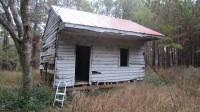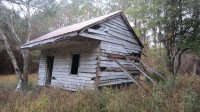 An antebellum slave cabin from the Point of Pines Plantation on Edisto Island, South Carolina, will become a centerpiece of the Smithsonian’s National Museum of African American History and Culture (NMAAHC), a new museum set to open in 2015. The cabin, one of two still standing on the plantation, was donated to the museum last month by the Edisto Island Historic Preservation Society who received it from the plantation’s owners, the Burnet Maybank family.
An antebellum slave cabin from the Point of Pines Plantation on Edisto Island, South Carolina, will become a centerpiece of the Smithsonian’s National Museum of African American History and Culture (NMAAHC), a new museum set to open in 2015. The cabin, one of two still standing on the plantation, was donated to the museum last month by the Edisto Island Historic Preservation Society who received it from the plantation’s owners, the Burnet Maybank family.
Quite a few slave cabins have survived despite their rickety construction, and there are several in museums, but the NMAAHC was particularly interested in acquiring one of the Point of Pines cabins because it was one of the first places where slaves emancipated themselves after Union occupation. Point of Pines was a large plantation where more than 170 slaves picked Sea Island cotton before the Civil War. The islands on the coast of South Carolina were taken by Union troops shortly after the war began. In 1861, almost two years before the Emancipation Proclamation declared slaves in Confederate territories free, Point of Pines slaves and slaves from neighboring plantations who had fled to Point of Pines, declared themselves free. The Point of Pines cabin therefore tells not just the story of the degradation of chattel slavery, but also of the triumph of self-determination.
 The fragile structure is being dismantled on site by Museum Resources, a Virginia company which specializes in historic woodwork. Smithsonian officials arrived on Monday to supervise the deconstruction and to do some on-site archaeological and historical research on the cabin and its inhabitants. The dismantlement process is a painstaking one. The first step is to marking and remove any non-period materials added to the historical structure. Then the siding and roofing comes off, then the roof framing and flooring, then the cabin frame. Every board and nail will be numbered and mapped before being carefully packed for transportation. The work is expected to take a week, after which the packaged cabin will be driven to the Williamsburg headquarters of Museum Resources where the wood will be dated, cataloged, its condition assessed and stabilized.
The fragile structure is being dismantled on site by Museum Resources, a Virginia company which specializes in historic woodwork. Smithsonian officials arrived on Monday to supervise the deconstruction and to do some on-site archaeological and historical research on the cabin and its inhabitants. The dismantlement process is a painstaking one. The first step is to marking and remove any non-period materials added to the historical structure. Then the siding and roofing comes off, then the roof framing and flooring, then the cabin frame. Every board and nail will be numbered and mapped before being carefully packed for transportation. The work is expected to take a week, after which the packaged cabin will be driven to the Williamsburg headquarters of Museum Resources where the wood will be dated, cataloged, its condition assessed and stabilized.
Once the pieces are given the all clear, the two-room, 16 by 20-foot cabin will be rebuilt inside the National Museum of African American History and Culture where it will be centrally located and visible from three floors. Because of its delicate condition, visitors will not be allowed to step into the cabin.
“This is one of the crown jewels of the collection, along with the Harriet Tubman shawl, Nat Turner’s Bible and an airplane used by the Tuskegee Airmen,” said Nancy Bercaw, a curator with the museum who is in South Carolina to monitor the cabin’s dismantlement. “It is there to remind us of the lives of people who were enslaved and definitions of freedom coming out of the African American community that led to transformational moments that changed America.”
Only a few days into the deconstruction, new information has been unearthed about the site. The cabin appears to have been built along a “slave street,” a row of up to 25 cabins similar to the surviving one.
 Preliminary documentary research has uncovered rich primary sources about Point of Pines slaves. One is the private register of the Rev. Edward Thomas, Rector of Edisto Island’s Trinity Church, which covers 1827 through 1829 and includes information about the plantation owners, the Bailey family, and their slaves. Another is the 1758 estate inventory of Joshua Grimball (Paul Grimball, the first European settler of Edisto Island in 1674, built the plantation; it stayed in his family until it was sold to the Baileys in 1789). Along with the furniture, tools, cattle, spinning wheels and glassware, it lists the names
Preliminary documentary research has uncovered rich primary sources about Point of Pines slaves. One is the private register of the Rev. Edward Thomas, Rector of Edisto Island’s Trinity Church, which covers 1827 through 1829 and includes information about the plantation owners, the Bailey family, and their slaves. Another is the 1758 estate inventory of Joshua Grimball (Paul Grimball, the first European settler of Edisto Island in 1674, built the plantation; it stayed in his family until it was sold to the Baileys in 1789). Along with the furniture, tools, cattle, spinning wheels and glassware, it lists the names of more than 90 Point of Pines slaves, among them Wando Pompey, the Wench Murriah, Big Sampson, Angolo Ned, Sambo and Gamboa Sampson. The African place names indicate first generation slaves.
of more than 90 Point of Pines slaves, among them Wando Pompey, the Wench Murriah, Big Sampson, Angolo Ned, Sambo and Gamboa Sampson. The African place names indicate first generation slaves.
With this valuable documentation and the help of Lowcountry Africana, a non-profit African American genealogy organization, Bercaw’s team is also interviewing local descendants of the Point of Pines slaves to add an oral history component to the future display about the cabin and the community that lived there slave and free.
Glad it goes to the museum, where it will be protected from the elements.
But there should be some sort of monument at the site where it originally stood.
…”(All) Black(s) girl, don’t lie to me, did you stay in the Pines ?”
Yes it is painstaking, but worth getting EXACTLY right. If every board and nail was not numbered and mapped before being packed for transportation, the last intact relics would be lost forever. Even once it arrives in Williamsburg, there will be a ton of work to be completed as you noted.
I wonder if it matters that visitors will not be able to step into the cabin. I took the grandchildren into the VERY primitive shearers’ cabin in the National Wool Museum in Geelong. The children could not believe how the estate owners made their workers live.
You’re right that actually being in the structure makes a profound impression. I hope they’ll be able to see inside clearly even if they can’t step inside.
Ralph Bailey III was my 4th Great Grandfather. He was married to Elizabeth Seabrook. I don’t know what type of slave owner he was but in my mind I hope he was kind and caring to his slaves. I’m glad that you where able to save such an important history for the African Americans.